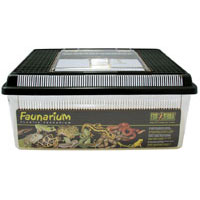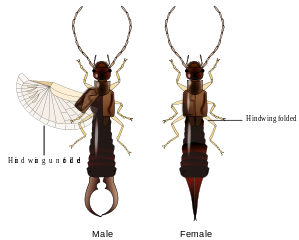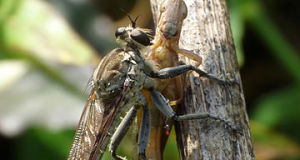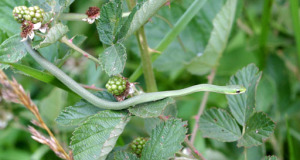Throughout my long career as a zookeeper and pet keeper, I have used wild caught insects to improve the diets of the amphibians, reptiles, fishes, invertebrates and birds under my care. While some cautions apply, the benefits conferred by the nutritional value of such foods far outweigh the risks involved. I have covered the collection and care of sow bugs, sap beetles, leaf litter invertebrates and many others in the articles linked below. Today I’ll discuss earwigs – common, hardy, and largely-ignored insects that have great potential as pet food. They are also extremely interesting in their own right, with females caring for their eggs and actually carrying food to the young!
Why Earwigs?
Earwigs are readily accepted by a wide variety of reptiles, amphibians, tarantulas, fishes, and scorpions, and provide nutrients absent from commercially-reared insects. They are quite common even in large cities, and can provide a significant amount of food for captive herps during the warmer months.
Earwigs are an ideal size (1- 1¼ inch) for both small and larger pets, and will be taken by animals ranging in size from Green Anoles to American Bullfrogs. They climb well, and quickly attract the attention of treefrogs and arboreal lizards. Despite the tough wing covers and pinchers, earwigs seem readily digestible, are not known to cause any related problems. As with crickets, earwigs should not be offered to ailing or debilitated animals, or to expectant females, as they have carnivorous tendencies.
Natural History
The world’s 1,800+ earwig species are placed in their own order, Dermaptera. Twenty-eight species – most introduced from elsewhere – occur in the USA. In the northeastern USA, I most frequently encounter the European Earwig, Forficula auricularia, which was first recorded here in 1907.
“Pinchers” on the abdomen and short, leathery wing covers (tegmina) lend earwigs a distinctive appearance. There are several flightless species; others fly only when necessary. I have seen the pinchers utilized as a defense against wolf spiders, but to no avail; they do not present a hazard to most herps or people. Males have curved pinchers, while those of the female are straighter in shape. Chemicals known as quinones are released in defense, but these have not deterred any of the animals I’ve worked with.
Earwigs are nocturnal and shelter below cover (boards, rocks, within flowers) or in self-dug tunnels by day. They feed upon carrion, decaying vegetation, fruits, fungi, moss, small insects and a wide variety of other foods. Many frequent rose bushes and other flowering plants, where they consume pollen and transfer some in the process. A few species appear to be specialized predators, but most are consummate omnivores.
Female European Earwigs (and others) care for their eggs by moving them about (perhaps to control temperature, humidity and fungus) and chasing off predators. They remain with the young until their first molt. Females of some species carry food to the hatchlings, while others provide regurgitated meals. One female that had a burrow in my yard would “herd” the young below ground each time I disturbed the area…she was always the last in. While visiting Japan, I was delighted to see that both zoos and private hobbyists keep earwigs; not so in the USA, unfortunately.
Collecting Earwigs
Earwigs release pheromones that attract others, which can result in large groups being found together at certain times of the years. I recently collect over 60 under a single cinder block in western NJ. Pairs sometimes overwinter together, with the female driving the male away in spring. Search for earwigs below dead logs, boards and in other likely hiding spots. Bring along a hand shovel, so that you can scoop up the surrounding earth, as they flee in all directions when disturbed. Earwigs also shelter among the leaves and flowers of certain bushes, where the “bush beating” collecting technique works very well; please see this article for details.
Trapping earwigs is quite simple. I use banana skins, ripe fruit and fish flakes as bait, but nearly any human food will work. Earwigs climb well, but are thwarted by coffee cans, so these are my containers of choice. If you add lots of banana skins or damp newspaper, the earwigs will often stay put even if able to escape. Traps can be buried in the ground or placed alongside a tree or other structure that allows easy access. I thwart raccoons, and other bait-stealers (usually!) by placing bait jars deep within rose bushes.
 Earwig Care
Earwig Care
The most difficult aspect of earwig care is keeping them confined. They can scale most glass and plastic, and will squeeze through the tiniest of openings. Plastic terrariums, especially “flat styles”, work well if insect screening is secured over the air vents. Alternatively, you can place an old towel over the top of the terrarium, and secure the cover above this. Plastic storage containers and old aquariums can also be put to use as earwig enclosures.
A mix of coconut fiber and leaf litter works well as a substrate; cork bark or other cover should also be available. The substrate should be kept moist via daily spraying. I house earwigs in a cool basement, but normal room temperatures will suffice.
When it comes to nutrient-loading, earwigs are as easy as most roaches; it is quite simple to provide them with a healthful diet. I use a variety of fruits and vegetables, fish flakes, leaf litter and Cricket Gutload Supplement, into which I mix a generous amount of Zoo Med ReptiCalcium. Vegetables and fruit provide earwigs with water, but they will also utilizeCricket Water Pillows.
Captive breeding on a large scale would likely be difficult, as gravid females seclude themselves from others. But, as mentioned above, it is a fascinating project for those interested in insect behavior.
Further Reading
Collecting Leaf Litter Invertebrates
Bush Beating: Collecting Arboreal Insects
Pitfall Traps for Invertebrates
 That Reptile Blog – Reptile, Amphibian and Exotic Pet Care and Information
That Reptile Blog – Reptile, Amphibian and Exotic Pet Care and Information






Greetings Frank. I read your article on earwigs eagerly. I am a research entomologist and have been looking for a source of earwigs to start our rearing program. I have not been able to find earwigs to purchase or anyone with the know how to collect and send earwigs. We are in an earwig difficient part of the country with only 2 species and finding an earwig is a rare event. Do you know where I could obtain a few dozen earwigs to start rearing?
Hello,
I’ve not seen them offered, unfortunately. I do not have a colony right now, and while many readers like the idea, I’m not sure how many have followed up!
I was about to suggest contacting Barney Tomberlain at Hatari Invertebrates, but his site is gone…he’s been supplying native inverts since the ’60’s, might have had leads. The company may be being run by an employee as Bugs of America.; give them a try. It may be worthwhile to post a request in the insect forum section of Arachnoboards; lots of serious hobbyists and some pro’s there, many with diverse interests. If that fails, I can try some local contacts, but it’s winter here in NY…; I can also ask an arachnologist friend in Louisiana, perhaps he or his students could help.
What are you working on?
Best, Frank
I live in the outskirts of Indianapolis and after living in my home 1 year I was overran with them. I’m a clean person, but they just kept coming and I kept bombing my house. I haven’t seen any this year, but my neighbor has and I now have a pet Chinese Dragon so I think Im gonna try to capture them and breed them for feeders since they are so common. Ive even taken some high quality photos of the earwigs I have found for reference. They are very annoying bugs and can infest a home quickly!
Hi Damon,
They can be hard to keep out of a house…they are often there for shelter, not food as is true for roaches, so cleanliness etc is not necessarily involved – but still, no one likes bugs in the house (unless they are in terrariums !). Let me know how all goes, best, frank